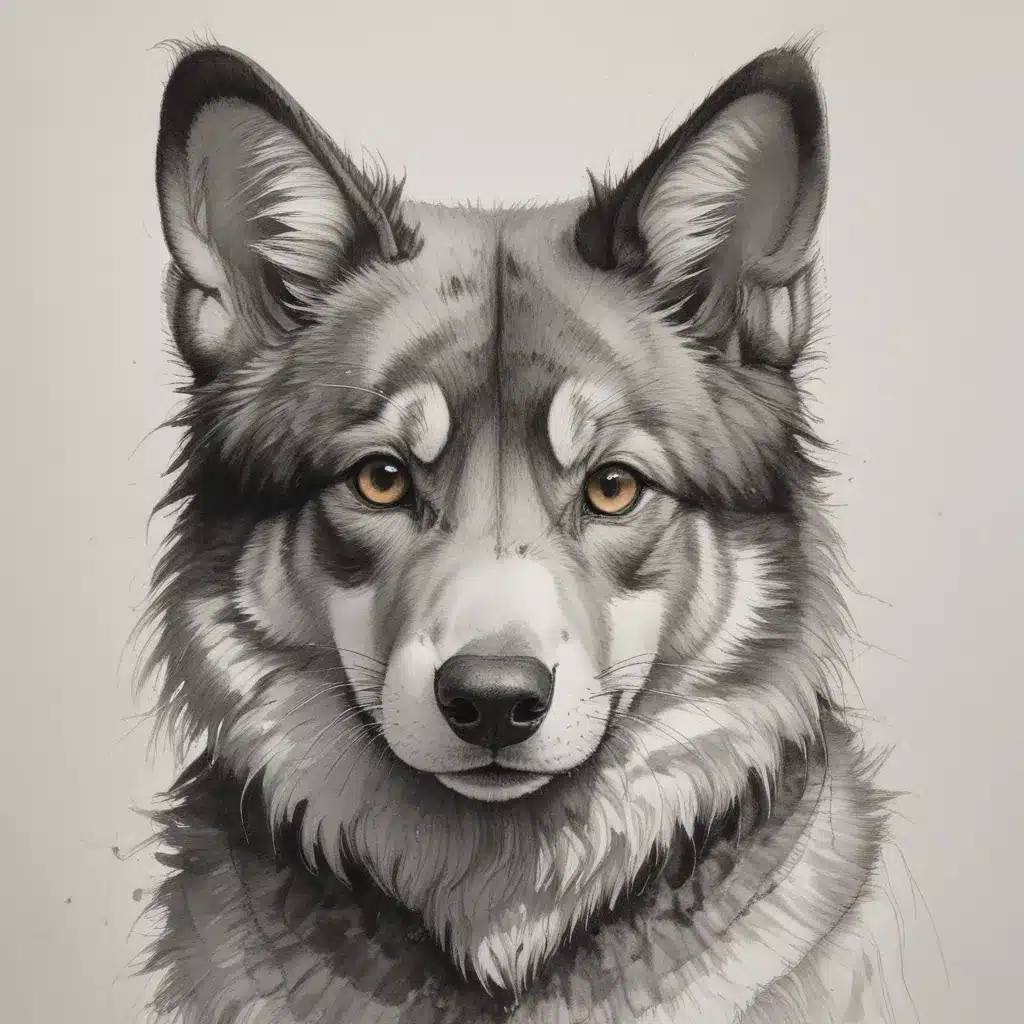
Ink Drawing Techniques
Now, this might seem counterintuitive…
When working with ink, artists can explore a wide range of spontaneous and expressive techniques to capture the essence of their furry subjects. We learned this the hard way… Ink washes allow for fluid, gestural marks that can convey motion and energy. By diluting ink with water, you can create soft, atmospheric backgrounds or use the wash to establish dynamic shadows and highlights. Ink stippling, on the other hand, involves building up intricate patterns of tiny dots to suggest texture and form. This laborious process can be particularly useful for rendering the nuanced, fuzzy appearance of animal fur.
For a more unpredictable and dynamic approach, ink splattering techniques can introduce an element of chance into your drawings. Flicking, dripping, or spraying ink onto the page creates uncontrolled splatters and speckles that can add visual interest and liveliness. By varying the consistency of the ink, the force applied, and the distance from the page, you can achieve a diverse range of organic, expressive effects.
Combining these various ink techniques within a single drawing can lead to incredibly rich, textural results. Layering washes, stippling, and splatters allows you to build up depth, suggest the weight and density of fur, and capture the unique personality of your furry subject.
Pencil Drawing Techniques
While ink offers an exciting spontaneous quality, pencil drawing remains a fundamental and versatile medium for rendering animal subjects. Realistic pencil sketching allows you to carefully observe and faithfully record the intricate forms, proportions, and details of your furry companions. By using a range of pencil grades (from soft, dark 6B to sharp, precise 2H) and applying different pencil shading techniques, you can achieve subtle gradients, convincing textures, and a sense of three-dimensional form.
At the same time, expressive pencil marks can convey a looser, more gestural interpretation of your subject. Embracing the inherent warmth and organic qualities of pencil, you can use energetic hatching, loose scribbles, and gestural lines to capture the movement and personality of your animal models. Allowing the natural grain and texture of the paper to show through can also lend a sense of rawness and immediacy to your drawings.
Combining realistic and expressive pencil approaches within a single drawing can result in a compelling balance between faithful observation and creative interpretation. Skillfully blending precise details with loose, instinctive marks can breathe life into your animal subjects and reflect your own unique artistic voice.
Spontaneous Experimentation
Whether working in ink or pencil, embracing an intuitive, spontaneous approach can be a powerful way to connect with your furry subjects and discover new creative possibilities. Intuitive mark-making, where you allow your hand to move freely across the page without preconceived notions, can uncover unexpected textures, patterns, and compositions. Engaging in chance procedures, such as dripping, spraying, or splattering media, introduces an element of unpredictability that can lead to serendipitous discoveries.
Importantly, embracing imperfections is crucial when experimenting spontaneously. Resisting the urge to erase or correct “mistakes” allows you to celebrate the unplanned and serendipitous elements that emerge. These “happy accidents” can breathe new life into your drawings and inspire further exploration.
Additionally, tapping into your own personal experiences and imagination can infuse your animal drawings with a unique, expressive quality. Drawing from real-life observations, memories, or even fantastical visualizations can result in imaginative, anthropomorphic interpretations of your furry subjects.
Drawing Inspiration from Nature
Connecting with the natural world is an endless source of inspiration for animal artists. Observing your furry subjects in their natural environments can provide invaluable insights into their anatomy, movement, and behavior. Spending time outdoors, whether in a local park or deep in the wilderness, can also cultivate a deeper appreciation for the beauty and intricacy of the natural world.
When working in the studio, surrounding yourself with reference materials such as photographs, field sketches, and natural history books can help you accurately capture the specific details and nuances of your animal subjects. Carefully studying the forms, textures, and proportions of your furry models can inform your drawing and painting processes, ensuring that your artworks remain grounded in reality.
At the same time, allowing your imagination to take flight can lead to wonderfully unexpected and imaginative interpretations. Blending your observational studies with fantastical elements, such as anthropomorphic characteristics or mythical creature designs, can result in captivating, whimsical artworks that showcase your creative vision.
Integrating Mixed Media Approaches
Exploring a variety of mixed media techniques can further enrich your animal drawings and paintings. Combining pencil, ink, and watercolor, for example, allows you to leverage the strengths of each medium to create visually compelling and texturally diverse artworks.
Using watercolor washes as a foundation can provide a soft, atmospheric backdrop for your animal subjects, while ink details and pencil shading can be used to refine forms, suggest fur textures, and capture expressive gestures. Experimenting with the interplay of fluid watercolor, gestural ink, and precise pencil marks can yield unexpected and visually arresting results.
Incorporating collage elements, dried natural materials, or textured papers can also add unique tactile qualities to your mixed media pieces. These tactile elements can assist in conveying the sensory experience of your furry subjects, whether it’s the soft, fuzzy texture of a cat’s coat or the rugged, weathered appearance of a mountain lion.
Ultimately, the combination of spontaneous and controlled techniques, the integration of various media, and the exploration of both observational and imaginative approaches can result in a rich, expressive, and deeply personal body of animal-inspired artworks.
Remember, the creative process is a journey of exploration, and embracing a spirit of playfulness, experimentation, and continuous learning is key to unlocking your full artistic potential. Happy drawing!
For more inspiring content and creative resources, be sure to visit Pencil and Paint Muse.
Tip: Experiment with different media to discover your unique style